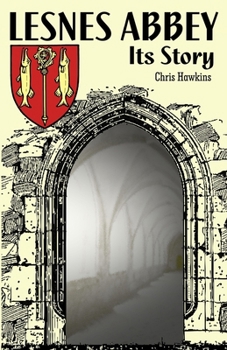Lesnes Abbey: Its Story
The ruins of Lesnes Abbey lie in the London Borough of Bexley close to the Royal Borough of Greenwich and a short walk from Abbey Wood station. They are the most impressive and complete ruins of an abbey within the M25, the only other example being Barking Abbey just across the Thames.
Founded in 1178 by Richard de Luci, arguably the wealthiest and most powerful man in England at that time, it was completed around 40 years later and was one of the largest in the country.
This book tells the story of Lesnes Abbey, from the impressive life of its founder to its restoration to what we see today. Covering over 800 years of English History, it explains what life was like in a medieval monastery, the use of the buildings that made up the abbey, and the challenges it faced over its 350-year life. These were not dissimilar from other abbeys, and so this book is also a useful guide to medieval religion and the rise and fall of monastic houses in general, taking Lesnes Abbey as a fairly typical example.
The dissolution is covered in detail, especially the fact that Lesnes Abbey was dissolved 10 years before most abbeys on the instigation of Cardinal Wolsey. It's post-suppression life as a manor house is covered with short biographies of its various owners before it was given to the charity Christ's Hospital and became a working farm. With the rapid urbanisation of London following the creation of the railways, it was feared that the abbey would be lost forever, covered over by housing estates, but with the enthusiastic support of local antiquarians and natural historians, it was saved and became the park now known as Lesnes Abbey Woods.
The aim of this book is to provide an up-to-date, accessible, and detailed history of Lesnes Abbey from before it was built to the incorporation of its ruins into a public park. It is not a purely academic book, but instead tells the story of the abbey and its occupants. Nor does it assume any knowledge of medieval ecclesiastical affairs, archaeology or history, explaining terms as they arise. To provide a historical context for the story, it describes the national events that shaped its destiny so that the factors behind the things that happened can be understood.
It is important to acknowledge that it builds on the academic publication of Alfred Clapham and the Woolwich and District Antiquarian Society from 1915, which remains the definitive account of the first systematic excavations of Lesnes Abbey and contains detailed original research into its history which has been used extensively.
The excavations of Lesnes Abbey took place between 1909 and 1913 and were led and funded by the Woolwich and District Antiquarian Society established by local historian W.T. Vincent in 1895. Without this commitment and work, there would be no Lesnes Abbey today. The first and second excavations are described in detail.
Forty years after the publication of Clapham's book, the ruins of the abbey were re-excavated and sensitively restored by London County Council. Frank Elliston-Erwood of the Woolwich and District Antiquarian Society, who had worked on the earlier excavations, directed this work.
Additional information from surveys and other research has become available, and some minor excavations of the site have added more to our understanding of Lesnes Abbey and the people associated with it, but, like most history from this time, many mysteries remain.
Richard de Luci (or de Lucy), the founder of the abbey, rarely gets mentioned by historians despite his many achievements and a lasting legal legacy, but is covered in detail to make clear how influential he was.
This book was published in 2025, 500 years after the dissolution of the abbey. It is certainly not the final word, but it does bring what is currently known together in one place and, most importantly, tells its story.
Related Subjects
History




